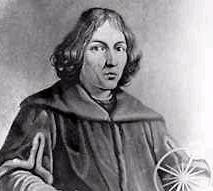 Copernicus, Nicolaus (1473-1543), Polish astronomer, best known for his astronomical theory that the sun is at rest near the center of the universe, and that the earth, spinning on its axis once daily, revolves annually around the sun. This is called the heliocentric, or sun-centered, system. See Astronomy; Solar System.
Copernicus, Nicolaus (1473-1543), Polish astronomer, best known for his astronomical theory that the sun is at rest near the center of the universe, and that the earth, spinning on its axis once daily, revolves annually around the sun. This is called the heliocentric, or sun-centered, system. See Astronomy; Solar System.Copernicus was born on February 19, 1473, in Thorn (now Toruń), Poland, to a family of merchants and municipal officials. Copernicus's maternal uncle, Bishop Łukasz Watzenrode, saw to it that his nephew obtained a solid education at the best universities. Copernicus entered Kraków Academy (now Jagiełłonian University) in 1491, studied the liberal arts for four years without receiving a degree, and then, like many Poles of his social class, went to Italy to study medicine and law. Before he left, his uncle had him appointed a church administrator in Frauenberg (now Frombork); this was a post with financial responsibilities but no priestly duties. In January 1497 Copernicus began to study canon law at the University of Bologna while living in the home of a mathematics professor, Domenico Maria de Novara. Copernicus's geographical and astronomical interests were greatly stimulated by Domenico Maria, an early critic of the accuracy of the Geography of the 2nd-century astronomer Ptolemy. Together, the two men observed the occultation (the eclipse by the moon) of the star Aldebaran on March 9, 1497.
In 1500 Copernicus lectured on astronomy in Rome. The following year he gained permission to study medicine at Padua, the university where Galileo taught nearly a century later. It was not unusual at the time to study a subject at one university and then to receive a degree from another—often less expensive—institution. And so Copernicus, without completing his medical studies, received a doctorate in canon law from Ferrara in 1503 and then returned to Poland to take up his administrative duties.
See: THE COPERNICAN SYSTEM AND ITS INFLUENCE .
